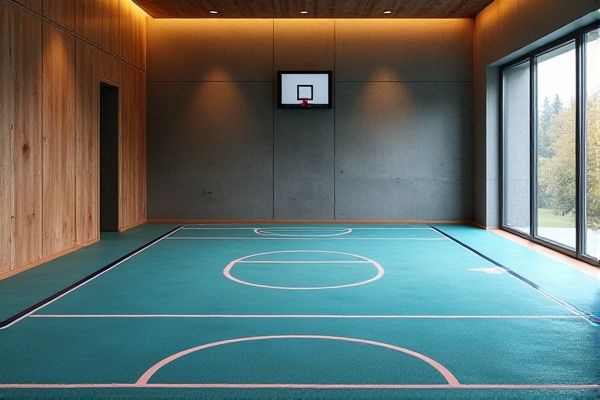
Rubber gym flooring offers superior durability, shock absorption, and resistance to heavy weights, making it ideal for high-impact workouts and commercial gyms, whereas EVA foam flooring provides a softer, lighter, and more affordable option suited for low-impact exercises and home use. Discover which flooring choice best fits Your fitness needs by reading the rest of the article.
Table of Comparison
| Feature | Rubber Gym Flooring | EVA Foam Flooring |
|---|---|---|
| Material | Natural or synthetic rubber | Ethylene Vinyl Acetate (EVA) foam |
| Durability | High resistance, long-lasting | Moderate, prone to wear over time |
| Shock Absorption | Excellent, ideal for heavy weights | Good, suitable for light workouts |
| Installation | Requires professional or heavy lifting | Easy, DIY-friendly interlocking tiles |
| Maintenance | Low maintenance, easy to clean | Requires frequent cleaning, can stain |
| Cost | Higher initial investment | Budget-friendly option |
| Water Resistance | Waterproof and non-slip | Water-resistant but can absorb moisture |
| Eco-friendliness | Often recyclable and sustainable | Less eco-friendly, synthetic foam |
| Use Case | Commercial gyms, heavy-duty workouts | Home gyms, low-impact exercises |
Introduction to Gym Flooring Options
Rubber gym flooring offers exceptional durability, shock absorption, and noise reduction, making it ideal for high-impact areas and heavy equipment. EVA foam flooring provides lightweight cushioning and ease of installation, suitable for low-impact workouts and home gyms. Choosing the right flooring depends on Your workout intensity, space, and maintenance preferences.
What is Rubber Gym Flooring?
Rubber gym flooring is a durable, high-density material designed to withstand heavy impacts, provide excellent shock absorption, and resist wear in fitness environments. Made from natural or synthetic rubber, it offers superior traction and noise reduction compared to EVA foam flooring. Its robust composition makes it ideal for commercial gyms and areas with heavy equipment, ensuring long-lasting performance and safety.
Overview of EVA Foam Flooring
EVA foam flooring offers a lightweight, shock-absorbing surface ideal for low-impact workouts and home gyms, providing excellent cushioning and comfort underfoot. It is resistant to moisture, easy to install, and available in interlocking tiles, making it a versatile option for various fitness spaces. Compared to rubber flooring, EVA foam tends to be more affordable and softer, but it may lack the durability and superior traction needed for heavy-duty gym equipment or high-intensity training.
Durability Comparison: Rubber vs EVA Foam
Rubber gym flooring offers superior durability compared to EVA foam, with higher resistance to wear, compression, and heavy impact from gym equipment. EVA foam, while lightweight and cushioning, tends to compress and degrade faster under intense use and heavy weights. Your gym space will benefit from rubber flooring's long-lasting performance, especially in high-traffic or commercial environments.
Impact Absorption and Cushioning
Rubber gym flooring provides superior impact absorption and cushioning due to its dense, resilient composition, making it ideal for high-impact workouts and heavy equipment. EVA foam flooring offers excellent cushioning with its lightweight, flexible structure, which reduces joint stress during low to moderate intensity activities but may not withstand heavy weights as effectively. The choice between rubber and EVA foam flooring depends on balancing durability and comfort requirements for specific gym activities.
Slip Resistance and Safety
Rubber gym flooring offers superior slip resistance due to its dense, textured surface that provides excellent traction even when wet, making it ideal for high-intensity workouts and heavy equipment areas. EVA foam flooring, while softer and more cushioned, generally has lower slip resistance and may become slippery with sweat or moisture, posing a higher risk during dynamic movements. Prioritizing safety, rubber flooring reduces slip-related injuries effectively, whereas EVA foam is better suited for low-impact exercises where cushioning is more critical than traction.
Maintenance and Cleaning Differences
Rubber gym flooring offers superior durability and resistance to stains, making it easier to clean with simple sweeping and occasional mopping using mild detergents. EVA foam flooring, while softer and more comfortable, tends to absorb moisture and dirt more readily, requiring more frequent deep cleaning and disinfecting to prevent mold and odors. Rubber surfaces resist wear and chemical damage better, reducing maintenance frequency compared to EVA foam, which may need replacement sooner due to its susceptibility to tearing and compression.
Cost Analysis: Rubber vs EVA Foam
Rubber gym flooring generally has a higher upfront cost compared to EVA foam flooring, with prices ranging from $4 to $8 per square foot, while EVA foam flooring typically costs between $2 and $5 per square foot. Rubber flooring offers superior durability and resistance to heavy weightlifting equipment, leading to lower long-term replacement and maintenance expenses. EVA foam, though more affordable initially, may require more frequent replacement due to lower durability, impacting overall cost efficiency in high-traffic gym environments.
Best Applications for Each Flooring Type
Rubber gym flooring excels in high-impact areas such as weight rooms and areas with heavy equipment due to its durability, shock absorption, and slip resistance. EVA foam flooring is best suited for low-impact zones like yoga studios, stretching areas, and children's playrooms because of its lightweight, cushioning, and comfort underfoot. Both materials provide excellent noise reduction and protection, but rubber offers superior resistance to tears, chemicals, and heavy foot traffic.
Final Verdict: Choosing Between Rubber and EVA Foam Flooring
Rubber gym flooring offers superior durability, shock absorption, and noise reduction compared to EVA foam, making it ideal for high-impact workouts and heavy equipment. EVA foam flooring is lighter, more affordable, and provides sufficient cushioning for low-impact activities and home gyms. Your choice depends on workout intensity, budget, and long-term flooring needs, with rubber excelling in durability and EVA foam prioritizing comfort and cost-efficiency.
 homyna.com
homyna.com